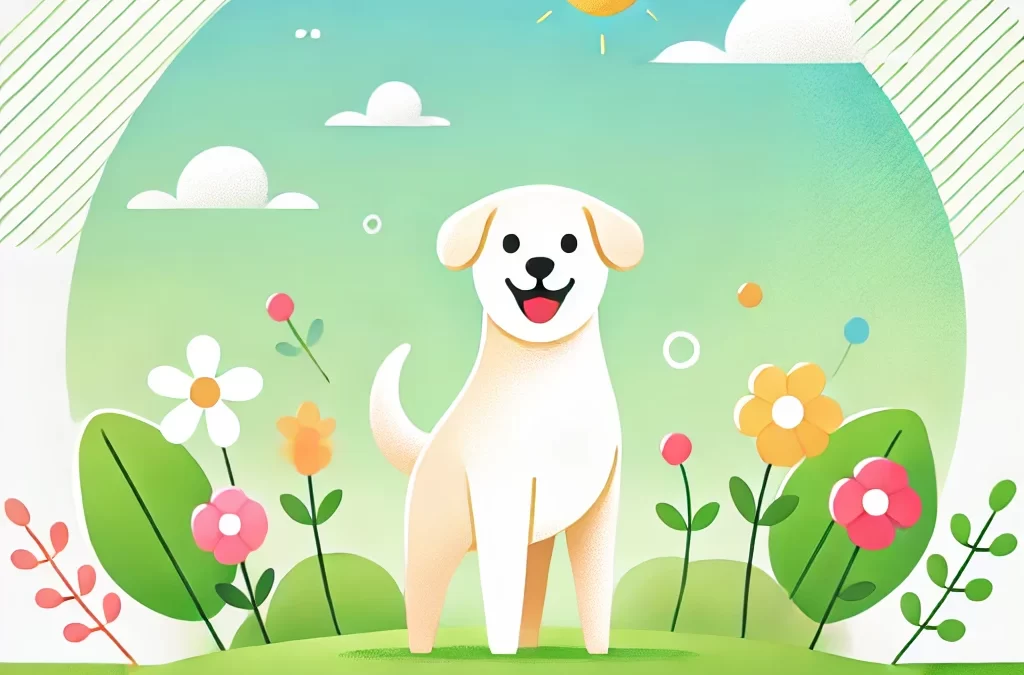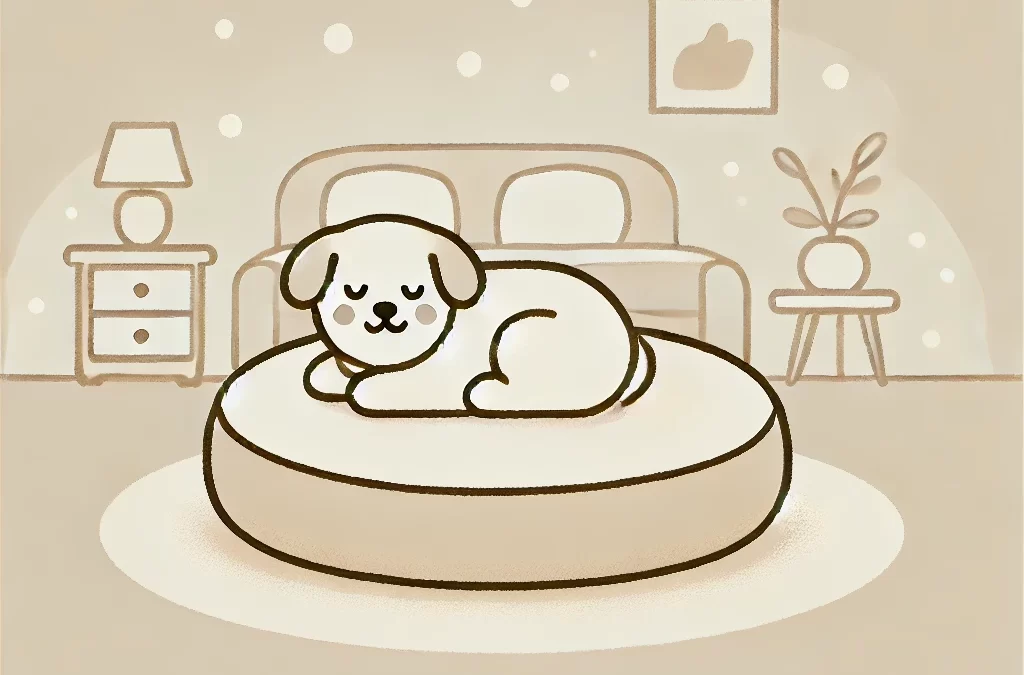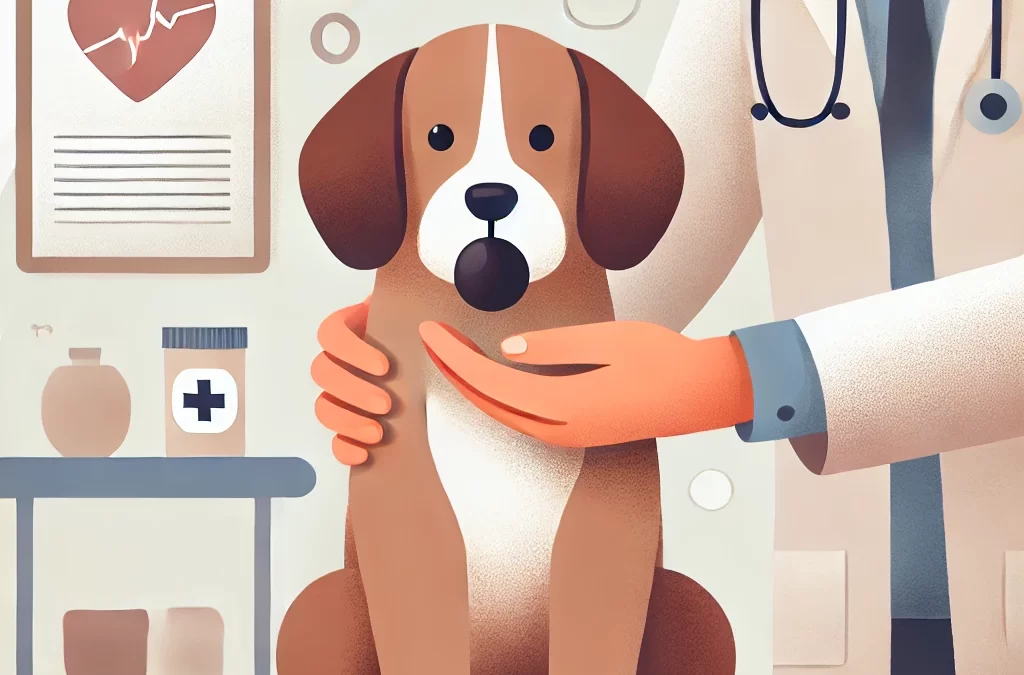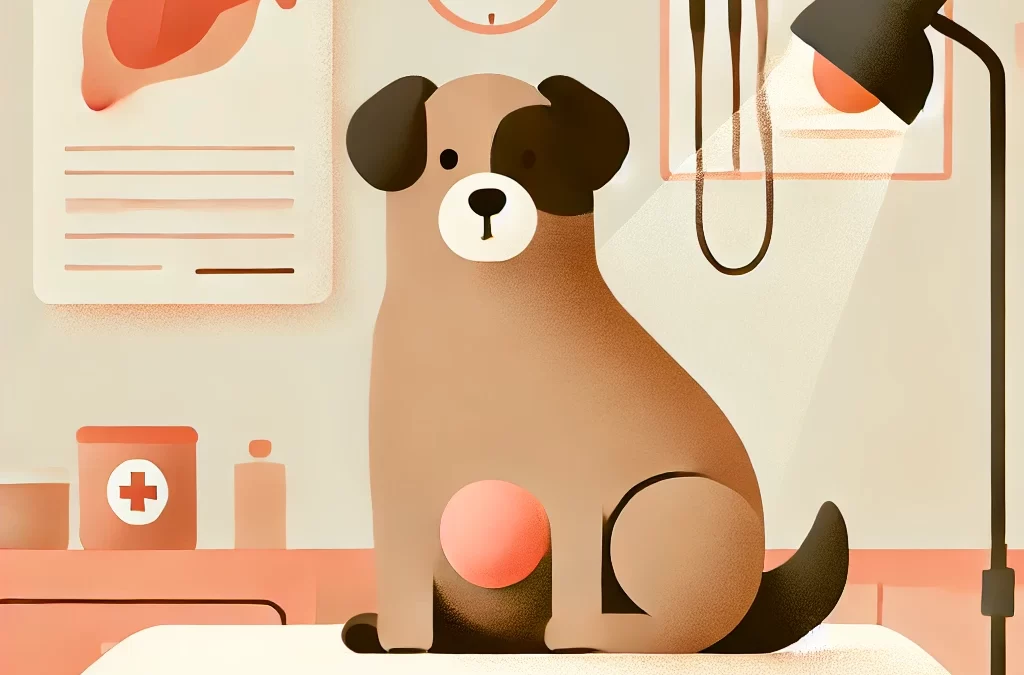
door TCMVET | 20 dec. 2024 | Hondenkanker en tumoren
Kanker bij honden is al lang een onderwerp van zorg voor huisdiereigenaren. Hoewel het natuurlijk is om je overweldigd te voelen wanneer je met deze diagnose wordt geconfronteerd, kan het begrijpen van de oorzaken inzicht bieden in preventie en zorg. Dit artikel duikt in de mogelijke redenen achter kanker bij honden, waarbij het licht werpt op genetische, omgevings- en levensstijlfactoren.
Genetische aanleg: een stille bestuurder
Een van de belangrijkste redenen waarom honden kanker krijgen, is genetica. Bepaalde rassen zijn vatbaarder voor kanker vanwege erfelijke eigenschappen. Golden Retrievers, Boxers en Rottweilers staan er bijvoorbeeld om bekend dat ze een grotere kans hebben op het ontwikkelen van kankers zoals lymfoom en osteosarcoom. Deze genetische aanleg benadrukt het belang van verantwoorde fokpraktijken om het risico te minimaliseren.
Milieutoxines: onzichtbare bedreigingen
Honden worden vaak blootgesteld aan omgevingsgifstoffen zonder dat hun baasjes het doorhebben. Pesticiden, herbiciden, meeroken en zelfs schoonmaakmiddelen voor in huis kunnen bijdragen aan de ontwikkeling van kanker. Langdurige blootstelling aan deze schadelijke stoffen kan mutaties in cellen veroorzaken, wat uiteindelijk leidt tot tumorgroei.
Dieet en obesitas: het risico voeden
Een slecht dieet met een tekort aan essentiële voedingsstoffen of veel bewerkte voeding kan het immuunsysteem van een hond verzwakken, waardoor ze vatbaarder worden voor kanker. Obesitas verergert het probleem nog verder door een ontstekingsomgeving in het lichaam te creëren. Het handhaven van een uitgebalanceerd dieet met veel antioxidanten en het vermijden van overvoeding kan het risico aanzienlijk verminderen.
Veroudering: een natuurlijke factor
Naarmate honden ouder worden, slijten hun cellen, waardoor de kans op kanker toeneemt. Oudere honden ervaren vaak een afname van de immuunfunctie, waardoor abnormale cellen ongecontroleerd kunnen woekeren. Dit maakt regelmatige veterinaire controles essentieel voor vroege detectie en interventie.
Overvaccinatie en medische factoren
Sommige onderzoeken suggereren dat overvaccinatie of onnodige medische procedures een rol kunnen spelen bij het verhogen van het risico op kanker. Hoewel vaccins cruciaal zijn voor het voorkomen van ziekten, kunnen overmatige of slecht getimede vaccinaties het immuunsysteem van een hond onder druk zetten. Raadpleeg altijd een vertrouwde dierenarts om een vaccinatieplan op maat te maken dat is afgestemd op de behoeften van uw hond.
Blootstelling aan de zon en UV-schade
Voor honden met een lichtgekleurde vacht of dunne vacht kan overmatige blootstelling aan de zon leiden tot huidkanker, met name in gebieden met weinig pigmentatie. Het beschermen van uw hond met huisdiervriendelijke zonnebrandcrème of het beperken van buitenactiviteiten tijdens de piekuren van zonlicht kan helpen.
Hoe u risico's kunt minimaliseren
- Evenwichtige voeding: Zorg voor een hoogwaardig dieet dat is afgestemd op de leeftijd, het ras en het activiteitsniveau van uw hond. Voeg natuurlijke bronnen van antioxidanten toe, zoals bosbessen en wortels.
- Beperk blootstelling aan toxines: Gebruik schoonmaakmiddelen die veilig zijn voor huisdieren en voorkom dat uw hond wordt blootgesteld aan pesticiden of tabaksrook.
- Regelmatige lichaamsbeweging: Zorg voor een gezond gewicht door regelmatig te bewegen.
- Routinebezoeken aan de dierenarts: Plan jaarlijkse controles en screenings in om mogelijke gezondheidsproblemen vroegtijdig te ontdekken.
- Op maat gemaakte vaccinatieplannen: Werk samen met uw dierenarts om een vaccinatieschema op te stellen dat past bij de levensstijl en de gezondheid van uw hond.
Afsluitende gedachten
Kanker bij honden is een complexe ziekte die wordt beïnvloed door een mix van genetische, omgevings- en levensstijlfactoren. Hoewel het onmogelijk is om alle risico's uit te sluiten, kan het nemen van proactieve maatregelen de kans op kanker aanzienlijk verkleinen. Door geïnformeerd en attent te blijven, kunnen huisdiereigenaren hun harige metgezellen de best mogelijke zorg en kwaliteit van leven bieden.

door TCMVET | 18 dec. 2024 | Hondenkanker en tumoren
Lymfoom is een van de meest voorkomende vormen van kanker bij honden en hoewel het vaak behandeld kan worden met behandelingen zoals chemotherapie, komt er een punt waarop de ziekte ondanks interventies kan verergeren. Het herkennen van de signalen dat uw hond het einde van zijn reis nadert, kan u helpen troost te bieden en weloverwogen beslissingen te nemen over zijn verzorging. Hier is een gids om de signalen van lymfoom in een laat stadium te begrijpen en hoe u uw geliefde huisdier kunt ondersteunen in deze moeilijke tijd.
Inzicht in hondenlymfoom
Lymfoom tast het lymfestelsel aan, dat deel uitmaakt van het immuunsysteem. Het kan zich in verschillende delen van het lichaam manifesteren, waaronder de lymfeklieren, milt, lever en het maag-darmkanaal. De progressie van de ziekte varieert, maar naarmate het vordert, raakt het lichaam steeds meer aangetast, wat leidt tot aanzienlijke fysieke en gedragsveranderingen.
Tekenen dat uw hond mogelijk sterft aan lymfoom
Ernstige vermoeidheid en lethargie
Honden met gevorderd lymfoom vertonen vaak extreme vermoeidheid. Uw ooit actieve huisdier kan het grootste deel van de dag slapend of liggend doorbrengen, en weinig interesse tonen in activiteiten waar ze vroeger van genoten.
Moeilijkheden met ademhalen
Lymfoom in de borstkas kan vochtophoping rond de longen veroorzaken, waardoor het voor uw hond moeilijk wordt om te ademen. Tekenen zijn onder andere snelle ademhaling, oppervlakkige ademhaling of zware inspanning.
Verlies van eetlust
Een stervende hond kan weigeren te eten of drinken, wat aangeeft dat hun lichaam het begeeft. Zelfs hun favoriete lekkernijen kunnen onaangeroerd blijven.
Gewichtsverlies en spierverlies
Naarmate de ziekte vordert, worden significant gewichtsverlies en spierverspilling (cachexie) zichtbaar. De ribben en ruggengraat van de hond kunnen meer uitgesproken worden.
Gezwollen lymfeklieren
Gezwollen lymfeklieren zijn een kenmerkend symptoom van lymfoom. Naarmate de ziekte het laatste stadium nadert, kunnen ze echter aanzienlijk groter worden.
Braken en diarree
Als lymfoom het maag-darmkanaal aantast, kan uw hond last krijgen van chronisch braken, diarree of beide. Deze symptomen kunnen leiden tot uitdroging en het lichaam verder verzwakken.
Pijn en ongemak
Uw hond kan tekenen van pijn vertonen, zoals gejank, moeite met liggen of onwil om te bewegen. Pijn kan het gevolg zijn van orgaanschade, ontsteking of druk veroorzaakt door tumoren.
Veranderingen in gedrag
Honden raken vaak teruggetrokken naarmate ze het einde van hun leven naderen. Ze kunnen interactie vermijden, eenzaamheid zoeken of gedesoriënteerd lijken.
Hoe u uw hond in deze tijd kunt ondersteunen
Raadpleeg uw dierenarts om er zeker van te zijn dat uw hond voldoende pijnbestrijding en palliatieve zorg krijgt. Medicijnen zoals middelen tegen misselijkheid, eetlustopwekkers en pijnstillers kunnen het comfort van uw hond verbeteren.
Creëer een rustige en vredige omgeving waar uw hond ongestoord kan rusten. Zorg voor zacht beddengoed en houd zijn favoriete spullen in de buurt.
Bied kleine hoeveelheden makkelijk verteerbaar voedsel aan als uw hond wil eten. Hydratatie is ook belangrijk, maar dwing hem niet om te drinken.
Breng quality time door met uw huisdier, bied zachte genegenheid en geruststelling. Aanwezig zijn kan enorm veel comfort bieden voor zowel u als uw hond.
Overweeg humane euthanasie als de kwaliteit van leven van uw hond aanzienlijk afneemt. Hoewel het een moeilijke beslissing is, kan het een meelevende manier zijn om hun lijden te verlichten.
Conclusie
Als u de signalen herkent dat uw hond mogelijk stervende is aan lymfoom, kunt u zich richten op zijn comfort en welzijn. De reis van elke hond is uniek en uw liefde en zorg in deze tijd zullen een betekenisvol verschil maken in hun laatste dagen.

door TCMVET | 18 dec. 2024 | Hondenkanker en tumoren
Inleiding: De stille vijand in de kankerzorg bij honden
Kankercachexie, een complex metabool syndroom dat wordt gekenmerkt door ernstig gewichtsverlies en spierverlies, is een stille maar dodelijke aandoening die veel honden met kanker treft. Cachexie wordt vaak overschaduwd door de primaire ziekte en heeft een aanzienlijke impact op de kwaliteit van leven, de reactie op behandeling en de algehele overleving van getroffen huisdieren. Het begrijpen en aanpakken van deze aandoening is cruciaal voor holistische kankerzorg bij honden.
What is Cancer Cachexia?
Kankercachexie is meer dan alleen gewichtsverlies. Het is een multifactoriële aandoening die wordt aangestuurd door de wisselwerking van systemische ontsteking, metabolische dysregulatie en de metabolische eisen van de tumor. Belangrijkste kenmerken zijn:
- Verlies van spiermassa: In tegenstelling tot simpele uithongering leidt cachexie tot spierverlies dat niet kan worden teruggedraaid door alleen een hogere calorie-inname.
- Appetite Changes: Honden kunnen minder interesse in eten (anorexia) of een veranderde smaakvoorkeur vertonen.
- Systemische ontsteking: Tumor-geïnduceerde ontstekingen verergeren metabolische onevenwichtigheden, waardoor de aandoening verder verergert.
Waarom ontstaat kankercachexie bij honden?
De exacte mechanismen van kankercachexie zijn complex en variëren afhankelijk van het type en stadium van kanker. Factoren die bijdragen aan deze aandoening zijn onder andere:
- Tumor Metabolism:Bepaalde tumoren scheiden stoffen af die de normale stofwisselingsprocessen verstoren, waardoor spieren en vet worden afgebroken.
- Cytokinen en hormonen: Verhoogde niveaus van pro-inflammatoire cytokinen (bijv. TNF-alfa) en hormonale onevenwichtigheden spelen een belangrijke rol bij het ontstaan van cachexie.
- Voedingstekorten: Een verminderde voedselinname en een verminderde opname van voedingsstoffen verslechteren de conditie van de hond.
Kankercachexie bij honden herkennen
Vroege detectie is de sleutel tot het beheersen van kankercachexie. Let op deze signalen:
- Onverklaarbaar gewichtsverlies ondanks voldoende voedselinname
- Spierverlies, vooral rond de wervelkolom en achterbenen
- Vermoeidheid en verminderde activiteitsniveaus
- Veranderingen in eetlust of eetgedrag
Innovatieve managementstrategieën
Hoewel er geen one-size-fits-all-oplossing is, kan een multimodale aanpak helpen cachexie bij honden te beheersen. Hier zijn enkele opkomende strategieën:
- Aangepaste voedingsondersteuning:Een dieet rijk aan hoogwaardige eiwitten, omega 3-vetzuren en specifieke aminozuren zoals glutamine kan helpen de spiermassa te behouden.
- Appetite Stimulants: Medicijnen zoals mirtazapine of capromoreline kunnen de eetlust en de voedselinname verbeteren.
- Anti-Inflammatory Therapies: Omega-3-supplementen en medicijnen die gericht zijn op ontstekingsreacties kunnen de cytokineactiviteit verminderen.
- Metabole modulatoren: Onderzoek naar medicijnen zoals anamoreline en ghreline-mimetica lijkt veelbelovend voor het terugdraaien van spierverlies.
De rol van integratieve geneeskunde
Natuurlijke therapieën, zoals Traditionele Chinese Geneeskunde (TCM), hebben laten zien dat ze symptomen kunnen verlichten. Kruiden zoals astragalus en ginseng kunnen de immuunfunctie en energieniveaus ondersteunen, terwijl acupunctuur de eetlust kan verbeteren en ontstekingen kan verminderen.
Vooruitkijken: de noodzaak van verder onderzoek
Ondanks de vooruitgang blijft kankercachexie onderbelicht in de diergeneeskunde. Samenwerking tussen dierenartsen, onderzoekers en huisdiereigenaren is essentieel om nieuwe therapieën te ontwikkelen en de uitkomsten voor getroffen honden te verbeteren.
Conclusie: hoop door innovatie
Hoewel kankercachexie een grote uitdaging vormt, bieden vorderingen in het begrijpen en behandelen van deze aandoening hoop. Door een holistische en proactieve aanpak te hanteren, kunnen we de kwaliteit van leven van honden die vechten tegen kanker verbeteren en hen helpen om met waardigheid en comfort van hun gouden jaren te genieten.

door TCMVET | 16 dec. 2024 | Hondenkanker en tumoren
Orale maligne melanoom (OMM) bij honden is een sluipende tegenstander. Bekend om zijn agressieve aard en snelle verspreiding, is het een diagnose die angst inboezemt bij huisdiereigenaren. Maar OMM is meer dan alleen een medische aandoening: het is een oproep tot actie voor huisdiereigenaren om waakzaamheid, innovatie en holistische zorg te omarmen. Laten we dit uitdagende onderwerp met een frisse blik onderzoeken, waarbij we zowel wetenschap als hoop onderzoeken.
Wat is oraal maligne melanoom?
Maligne oraal melanoom is een type kanker dat ontstaat in de melanocyten, cellen die verantwoordelijk zijn voor de pigmentproductie in de huid en slijmvliezen. Hoewel het meestal in de mond voorkomt, stopt deze kanker daar niet. Het staat bekend om zijn vermogen om nabijgelegen weefsels binnen te dringen en uit te zaaien naar verre organen zoals de longen en lymfeklieren.
Deze aandoening komt het meest voor bij honden van middelbare leeftijd tot oudere honden, met name rassen met donker gepigmenteerd tandvlees, zoals Cocker Spaniels, Chow Chows en Scottish Terriers. Ondanks de grimmige reputatie kan het begrijpen van de symptomen en behandelingsopties van OMM eigenaren in staat stellen om weloverwogen beslissingen te nemen.
De signalen herkennen
Maligne melanoom van de mond blijft vaak onopgemerkt totdat het vergevorderd is, waardoor regelmatige controles van de mond cruciaal zijn. Veelvoorkomende symptomen zijn:
- Een donkere of onregelmatige massa in de mond, op het tandvlees of op de lippen.
- Bloeden, een slechte adem of kwijlen.
- Moeilijkheden met eten, kauwen of slikken.
- Zwelling van het gezicht of vergrote lymfeklieren.
Als u een van deze symptomen opmerkt, raadpleeg dan onmiddellijk uw dierenarts. Vroege detectie kan de uitkomst aanzienlijk beïnvloeden.
Verder kijken dan traditionele behandelingen: innovatie omarmen
Conventionele behandelingen voor OMM omvatten chirurgie, radiotherapie en chemotherapie. Hoewel ze in veel gevallen effectief zijn, zijn deze opties niet altijd toegankelijk of betaalbaar. Hier zijn enkele innovatieve en integratieve benaderingen die aandacht krijgen:
- Immunotherapie vaccins: Een game-changer in oncologie, OMM-specifieke vaccins, zoals het canine melanoma vaccin (ONCEPT®), stimuleren het immuunsysteem van de hond om kankercellen te bestrijden. Deze geavanceerde behandeling heeft veelbelovende resultaten laten zien in het verlengen van de overlevingstijd.
- Fotodynamische therapie (PDT): Deze techniek gebruikt licht-geactiveerde medicijnen om kankercellen selectief te vernietigen, waarbij omliggend gezond weefsel gespaard blijft. Het is een minder invasieve optie voor bepaalde gevallen.
- Holistische supplementen: Natuurlijke supplementen zoals curcumine (gevonden in kurkuma), medicinale paddenstoelen en omega-3-vetzuren worden onderzocht op hun ontstekingsremmende en immuunversterkende eigenschappen. Raadpleeg altijd een dierenarts voordat u supplementen gaat gebruiken.
De rol van voeding bij herstel
Een kankerdiagnose vraagt om een verandering in dieetstrategieën. Honden die vechten tegen OMM hebben baat bij een dieet dat is afgestemd op hun metabolische behoeften. Focus op:
- Hoogwaardige eiwitten: Mager vlees en vis om spiermassa te behouden.
- Gezonde vetten: Omega-3-vetzuren bestrijden ontstekingen en ondersteunen de algehele gezondheid.
- Opties met weinig koolhydraten: Kankercellen gedijen goed op suiker. Door de inname van koolhydraten te beperken, kunt u hun groei vertragen.
Zelfgemaakte, door de dierenarts goedgekeurde maaltijden kunnen een geweldige manier zijn om ervoor te zorgen dat uw hond optimale voeding binnenkrijgt.
Emotionele en praktische ondersteuning voor huisdiereigenaren
Zorgen voor een hond met OMM is emotioneel even veeleisend als uitdagend. Zo navigeer je door deze reis:
- Creëer een dagelijkse verzorgingsroutine: Door consistent te zijn, kunt u stress voor zowel u als uw hond verminderen.
- Zoek steun bij de gemeenschap: Online forums en lokale ondersteuningsgroepen voor huisdiereigenaren die met kanker bij hun hond te maken hebben, kunnen troost en waardevolle inzichten bieden.
- Ontdek de mogelijkheden voor palliatieve zorg: Als curatieve behandeling geen optie is, richt u dan op pijnbestrijding en het verbeteren van de kwaliteit van leven van uw hond.
Een glimp van hoop
Hoewel oraal maligne melanoom bij honden een geduchte vijand is, veranderen ontwikkelingen in de diergeneeskunde en integrale zorg het verhaal. Vroege detectie, innovatieve behandelingen en een focus op holistisch welzijn stellen huisdiereigenaren in staat om terug te vechten tegen deze ziekte.
De diagnose van uw hond definieert de reis niet, het is een hoofdstuk in het verhaal van hun veerkracht, liefde en de band die u deelt. Blijf vragen stellen, oplossingen zoeken en elk moment koesteren.

door TCMVET | 16 dec. 2024 | Hondenkanker en tumoren
Het ontdekken van een knobbel op de buik van uw hond kan alarmerend zijn. Als huisdiereigenaren is onze eerste reactie vaak bezorgdheid, maar niet alle knobbels zijn gevaarlijk. Sterker nog, veel zijn goedaardig en beheersbaar met de juiste verzorging. Om u te helpen deze situatie te doorstaan, volgt hier een frisse kijk op het begrijpen, identificeren en aanpakken van knobbels in de buik bij honden.
Wat is precies een maagknobbel?
Een maagknobbel bij honden verwijst naar een abnormale massa of zwelling in het buikgebied. Deze kunnen variëren in grootte, vorm en textuur: sommige voelen zacht en beweeglijk aan, terwijl andere stevig kunnen zijn of vastzitten aan onderliggende weefsels.
De sleutel tot het omgaan met zulke bulten ligt in observatie en tijdige actie. Laten we, voordat we conclusies trekken, de meest voorkomende oorzaken achter deze groeisels onderzoeken.
Veelvoorkomende oorzaken van maagknobbels
- Lipomen (vetgezwellen): Dit zijn goedaardige, zachte en langzaam groeiende bulten die vaak voorkomen bij oudere honden. Lipomen vormen zelden een gezondheidsrisico en zijn meestal meer een cosmetisch probleem.
- Hematomen of abcessen: Als uw hond onlangs een trauma heeft gehad, kan de bult een hematoom zijn (een verzameling bloed onder de huid) of een abces veroorzaakt door een infectie. Deze zijn vaak warm en gevoelig bij aanraking.
- Hernia's: Hernia's ontstaan wanneer interne weefsels of organen door een zwakke plek in de buikwand heen duwen. Ze kunnen zacht aanvoelen en verminderen wanneer er zachtjes op wordt gedrukt.
- Kwaadaardige tumoren: Helaas zijn sommige knobbels kankerachtig. Mastceltumoren, wekedelensarcomen en andere kwaadaardige aandoeningen vereisen vaak onmiddellijke veterinaire aandacht en behandeling.
- Cysten of talgkliergroei: Dit zijn vaak met vocht gevulde zakjes of verstopte klieren die op de maag van uw hond kunnen verschijnen. Ze zijn over het algemeen ongevaarlijk, maar kunnen drainage of een kleine operatie vereisen als ze te groot worden.
Tekenen die onmiddellijke aandacht vereisen
Hoewel niet alle maagknobbels reden tot bezorgdheid zijn, zijn er bepaalde symptomen die erop wijzen dat een spoedbezoek aan de dierenarts noodzakelijk is:
- De bult wordt snel groter.
- Uw hond lijkt pijn te hebben als hij de plek aanraakt.
- De knobbel is hard, onbeweeglijk of onregelmatig van vorm.
- Er is sprake van roodheid, zwelling of afscheiding uit het gebied.
- Uw hond vertoont tekenen van lusteloosheid, verlies van eetlust of andere systemische problemen.
Wat te doen als u een knobbel ontdekt
- Houd de bult in de gaten: Houd de grootte, textuur en het gedrag bij. Door elke paar dagen foto's te maken, kunt u eventuele veranderingen opmerken.
- Plan een bezoek aan de dierenarts: Uw dierenarts kan een lichamelijk onderzoek uitvoeren en diagnostische tests aanbevelen, zoals een fijnenaaldaspiratie, biopsie of echografie, om de aard van de knobbel te bepalen.
- Overweeg behandelingsopties: Afhankelijk van de diagnose kan uw dierenarts observatie, medicatie, operatie of andere therapieën voorstellen. Voor goedaardige gezwellen zoals lipomen is behandeling mogelijk niet nodig, tenzij de bult ongemak veroorzaakt.
- Ontdek natuurlijke remedies (met goedkeuring van de dierenarts): Voor niet-kwaadaardige gezwellen wenden sommige huisdiereigenaren zich tot natuurlijke supplementen zoals kurkuma, omega-3-vetzuren of kruidenbehandelingen die de algehele immuungezondheid bevorderen. Raadpleeg altijd uw dierenarts voordat u een nieuw supplement introduceert.
Preventietips voor een gezonde hond
- Regelmatige controles: Vroege detectie is de sleutel tot het effectief behandelen van knobbels. Regelmatige bezoeken aan de dierenarts zorgen ervoor dat eventuele veranderingen snel worden aangepakt.
- Gebalanceerd dieet: Een dieet dat rijk is aan voedingsstoffen kan de algemene gezondheid en immuniteit van uw hond ondersteunen.
- Behoud een gezond gewicht: Obesitas verhoogt het risico op vettige tumoren en andere gezondheidsproblemen. Houd uw hond actief en op een ideaal gewicht.
- Huidverzorging: Door de vacht en huid van uw hond regelmatig te verzorgen en te inspecteren, kunt u afwijkingen vroegtijdig opsporen.
Een woord van troost
Niet elke knobbel is levensbedreigend en vooruitgang in de diergeneeskunde heeft de diagnose en behandeling effectiever gemaakt dan ooit. Door oplettend en proactief te blijven, kunt u ervoor zorgen dat uw hond gelukkig en gezond blijft.
Als u een knobbel in uw maag opmerkt, haal dan diep adem en neem contact op met uw dierenarts. Samen vinden jullie de beste weg vooruit voor uw harige metgezel.
Tags: maagknobbel bij honden, oorzaken van knobbels bij honden, behandeling van knobbels bij honden, gezondheidszorg voor honden, goedaardige tumoren bij honden, natuurlijke remedies voor honden





